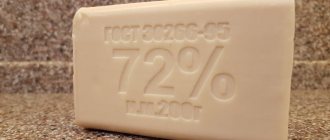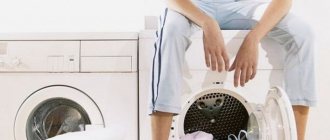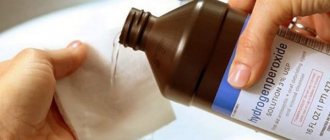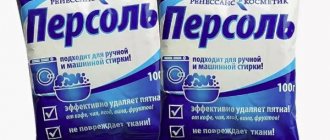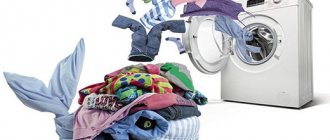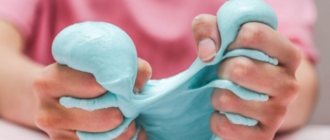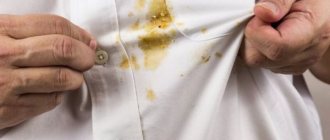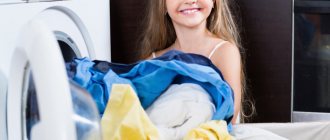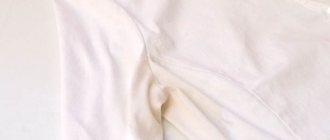Beton-House.com
Website about concrete: construction, characteristics, design. We combine the experience of professionals and private craftsmen in one place
Over time, white things lose their original appearance, no matter how carefully you handle them. Various factors lead to the appearance of yellowness and grayness. Sometimes regular washing is not enough, so you have to resort to bleaching. We'll tell you how to effectively bleach any fabric products at home.
Aspirin
Using aspirin to whiten clothes is considered a cheap and safe way. The components of the drug penetrate deep into the fibers and remove contaminants. It is important to adhere to the basic rules of dosage and sequence of actions both when washing by machine and by hand. This will allow light-colored items to retain their original appearance.
You can bleach clothes in a washing machine as follows:
- Grind two or three tablets and add to washing powder. Pour the resulting mixture into a special compartment, then turn on the selected program.
- Place the required number of tablets of the drug in the drum along with the clothes and set the appropriate washing mode.
Use this method of whitening if absolutely necessary. Frequent use of aspirin can damage the parts of your washing machine.
Whitening things manually consists of two manipulations:
- Soaking, during which a proportion of 1 aspirin tablet per 1 liter of water is used. Fabric items are soaked for at least 10 hours.
- Wash in the usual way.
Tips for not having to bleach
Proper care of clothing will reduce the likelihood of yellowing and staining of items. The main recommendations include:
- Sort your items when you throw them in the wash. Place white items separately from other items. Do not place cotton or linen ones next to each other, they will begin to turn grey.
- Follow label directions. Most often, color loss is caused by non-compliance with the washing temperature indicated on the label.
- Try to wash white clothes immediately after going outside.
- Dry white items naturally, in the sun. It allows you to maintain brightness.
- Place items that are completely dry for storage in the closet. Even slightly damp clothes will turn gray in a week.
- Place colored and white items separately to prevent them from packing and transferring dye to your white clothes.
- The grayness of white items can be caused by the presence of powder and conditioner residues in the fabric fibers. Therefore, resort to additional rinsing of white items.
Snow-white tablecloths, shirts and sheets are susceptible to environmental influences, frequent washing and contamination. Under the influence of such factors, things acquire a yellow and gray tint. Read on to learn about at-home whitening methods.
Soda
You can return the original white color to fabric products without boiling. Baking soda will help in bleaching light-colored fabrics and will also preserve their structure for a long time. Dissolve 1 tbsp in one liter of water. l. soda and 0.5 tbsp. l. ammonia. Soak things for 3 hours.
This bleaching method is well suited for children's clothes. Soda does not cause allergic reactions and is safe for baby's skin. Some types of stains need to be boiled with a soda solution for 30 minutes. The effect will be better than after chemical bleaches.
We use boiling
Check the laundry label before using the boiling procedure. White items made from delicate fabrics should not be boiled. Disadvantages of boiling things down:
- Appearance of a gray tint.
- Hardening of tissue fibers after the procedure.
These shortcomings can be eliminated by using bleach and rinsing with conditioner.
The procedure involves boiling white linen in a special solution. The duration of the procedure is 45 minutes. The clothes are immersed in an iron bucket or pan after the bleach solution boils.
The following solutions are used for digestion:
Powder, vegetable oil, soda and bleach . In an iron pan, add a tablespoon of oil and a spoonful of bleach. After the liquid boils, add three tablespoons of powder and two tablespoons of soda. Stir the solution until the components dissolve. Then load the laundry. Perform the boiling procedure over low heat. Finally, rinse the product in cool water. When boiling things, cover them with two fingers of water.
Baking soda with potassium permanganate . The solution is suitable for washing baby diapers. Add three liters of water, three tablespoons of soda and five crystals of potassium permanganate to the container. Don't overdo it with the last component.
Laundry soap with soda . To prepare the product, take two liters of water, three tablespoons of chips and soda. Carry out the boiling procedure described above. Finally, rinse the items in warm water with conditioner.
Lemon acid . Dissolve a bag of lemon juice in 5 liters of water. Boil the mixture over low heat. Immerse the product in the container. Boil the dull underwear for forty-five minutes.
Mustard powder and salt . Prepare a bleach solution. For a liter of water, a teaspoon of mustard and salt. After boiling, rinse the product with conditioner.
Hydrogen peroxide
Peroxide has an excellent effect as a bleach before washing. Fill an enamel container with five liters of water and heat to 70℃. Then pour in 2 tbsp. l. hydrogen peroxide and half a spoon of ammonia. Soak the items in the resulting bleaching liquid for 20 - 30 minutes; after washing, they will become much lighter.
If the color of washed fabric products is not satisfactory, soak them in a mixture of 2 liters of water and 1 tsp. peroxide for 30 minutes. Rinse in cold water. Keep in mind that the shelf life of the drug after opening is only one month.
Home remedies or bleach
When choosing a whitening product, consider the effectiveness and safety of the ingredients. For a white children's bed, use soda, potassium permanganate and laundry soap. Such components disinfect fabric fibers. Industrial products are toxic and cause allergies even in adults.
Among industrial products, give preference to oxygen bleaches. On the farm, such products can be replaced with hydrogen peroxide. The antiseptic drug does not harm the health and parts of the washing machine.
Mustard powder
Mustard powder will be a real salvation for greasy kitchen napkins and towels. In five liters of boiling water you need to dissolve 5 tbsp. l. mustard. Leave the resulting solution to infuse for three hours. After a while, strain the mixture through cheesecloth. Place the items in a washing container and fill them with mustard liquid.
For minor stains, soaking should be carried out for 20 - 30 minutes. Then wash the fabric items in a soapy solution with added laundry soap, rinse and dry.
Useful tips
The presence of a color pattern complicates the bed whitening procedure. Vanish or Amway bleach will help correct the situation. Choose a product depending on the type of fabric. Initially, you will need to remove stains from the white areas of the product. Then wash the product in a washing machine. Instructions for using bleach are indicated on the packaging. When the laundry turns gray or yellowed, use a mixture of 3 tablespoons of baking soda and 2 teaspoons of hydrogen peroxide. The prepared solution is added to the powder during hand washing. Then rinse the product with conditioner.
When soaking and boiling laundry, observe the dosage of the products and the duration of the procedure. Otherwise, the product will become unusable.
Snow-white linen indicates the housewife's neatness. If you know other methods of whitening things, write about them in the comments to the article.
Potassium permanganate (+laundry soap)
Using potassium permanganate you can remove yellowness and save faded things. The product has long been known for its whitening properties. Copes perfectly with stains on any type of fabric.
To begin, dissolve a few crystals of potassium permanganate in a glass of warm water. Then you need to add 100 - 150 grams of fine shavings of laundry soap and a solution of potassium permanganate to a container with ten liters of water. Soak washed items in the resulting liquid for at least 30 minutes. Soaking time depends on the thickness of the fabric. The thicker it is, the longer this process should take. The last manipulation is to thoroughly rinse the items.
Potassium permanganate does not cause thinning of the fibers and does not damage the fabric. This method of whitening is recognized as one of the most gentle.
All of the above methods are gentle. Therefore, there is no reason to worry about expensive things, they will remain unharmed. But old stains, grayness and yellowness will instantly disappear from white things.
Bleaching things
The effectiveness of the procedure depends on the correct selection of the product and method. Pre-soaking white laundry will help achieve better whitening results. Depending on the type of fabric, they can be washed by hand or using a washing machine.
You can restore the snow-whiteness of cotton items by soaking or boiling.
It is recommended to bleach a lace set of underwear with Vanish. The boiling procedure cannot be used. To remove complex stains, you will need to soak the kit in warm water with bleach. The dosage of Vanish is indicated on the packaging. The duration of the procedure is at least three hours. Then wash the product as usual.
It is recommended to soak snow-white items made from synthetic fabrics in a self-prepared solution. They use soda, ammonia, salt, potassium permanganate, laundry soap and other substances. Next we will tell you in more detail about the soaking procedure.
Video
We offer you to watch a video on the topic of the article:
She graduated from the author's physics and mathematics lyceum and art school. Received a higher education in economics with a major in innovative management. Freelancer. Married, actively travels. He is interested in Buddhist philosophy, enjoys transurfing and loves Mediterranean cuisine.
Found a mistake? Select the text with the mouse and click:
Stretch ceilings made of PVC film can withstand from 70 to 120 liters of water per 1 m2 of their area (depending on the size of the ceiling, the degree of its tension and the quality of the film). So you don’t have to worry about leaks from neighbors above.
There are special traps to combat moths. The sticky layer with which they are covered contains female pheromones that attract males. By sticking to the trap, they are eliminated from the reproduction process, which leads to a decrease in the moth population.
The easiest way to remove scale and carbon deposits from the soleplate of the iron is with table salt. Pour a thick layer of salt onto the paper, heat the iron to maximum and run the iron over the salt bed several times, applying light pressure.
Effective ways to combat yellowness
Traditional methods of bleaching linen made of silk or wool involve the use of products that any housewife always has on hand. For cleaning you will need the following:
- 20 ml of ammonia;
- 9 tbsp. l. salt;
- 30 ml peroxide;
- 70 g gentle washing powder;
- 12 liters of purified water (temperature - 40 degrees).
Damaged items must be soaked in a solution of these components for 5 hours (they must be washed in advance).
Bleaching of underwear (silk, lace) should be done with extreme caution to avoid damaging the sensitive material. The following are unacceptable: choosing a high temperature cleaning mode, machine washing, using chlorine-containing compounds. The best way to preserve the attractive appearance of underwear and bright white color is table salt and baking soda. When washing by hand, each component is added in an amount of 10 g. Many housewives use mustard diluted in water (2-3 tablespoons of product) to whiten their favorite items. After soaking the laundry in a water-mustard solution, washing is required.
Whitening for bleaching can only be used if you plan to clean products made of strong and dense materials. This product is good for returning the bright white color to tablecloths, bed linens (not silk), towels or cloth napkins. It is not recommended to soak things in white for a long time, maximum 20 minutes. When working with this product, be sure to use gloves.
Possible causes of poisoning in children
Poisonous products can cause poisoning to a child.
Food poisoning is conventionally divided into 2 types. However, this conditional division does not reduce the danger to the child’s health. So, there are 2 types of food poisoning:
- Poisoning a child with poisonous products. Such poisoning can occur due to the child’s consumption of poisonous berries, mushrooms or plant seeds.
- Poisoning with toxic substances. Such poisoning refers to poisoning resulting from ingestion of food containing pathogens and toxic substances.
I don’t even know if it can be said that poisoning with toxic substances is even worse than poisonous products, but it is a fact that such poisoning can lead to intoxication or some kind of pathology.
Do not confuse toxin poisoning with food poisoning. It differs from poisoning in that it has a short incubation period. This infection is not contagious, so it is safe to contact a child with toxoinfection. Most often, food poisoning occurs after consuming the following foods:
- Eggs (especially if they have cracked shells or raw eggs)
- Seafood
- Sweets with cream
- Greens and root vegetables
- Milk and dairy products
I think that there is no point in talking about salads and other finished products on supermarket shelves, because... This food is a treasure trove for E. coli, salmonella and staphylococcus.
If your child feels fine after eating finished products from the supermarket, then you can consider it a miracle.
It is definitely difficult to prevent your child from eating fruit or one serving of ice cream in the summer heat. And, strictly speaking, there is no need to do this. It is enough to simply be more careful when choosing a product.
When buying something for your child in a store, make sure that you are buying quality products and also pay attention to their expiration date. You can only rest easy knowing that your child is eating quality products that were manufactured by a reliable company in compliance with sanitary and hygienic standards.
Features of pollution
Potassium permanganate, or potassium permanganate, is a universal antiseptic that is used to disinfect wounds and planting material. All you need to prepare the solution is stir the pink powder in water. When using an antiseptic, accidents happen and the liquid ends up on the floor, clothes and furniture.
Manganese solution stains cannot be washed off with water or cleaning agents. And a strong concentrate generally destroys the upper layers of the fabric, as if burning the fibers.
Manganese cannot be washed from clothes even with the most expensive powders and bleaches. It is recommended to use acids for cleaning.
Prevention of food poisoning in children
You must wash your hands before eating.
To prevent food poisoning in a child, you need to wash your hands more often, put away anything that could harm your child’s health and refuse raw water.
In this matter, you need to be not only attentive to the child’s actions, but also to yourself. For example:
- Give your child only washed vegetables and fruits
- Wash your hands before preparing food
- Monitor the expiration date of purchased products
In fact, this list can be very long, but the most important thing is to maintain good hygiene and ensure your child is eating properly.
What symptoms indicate poisoning of a child?
An elevated temperature in a child is a sign of poisoning.
In case of poisoning, the child’s symptoms will appear unexpectedly with an increasing character, i.e. at first there may be nausea, followed by vomiting, and vomiting will be accompanied by high fever, etc.
In case of mild poisoning, the child’s health may be satisfactory, but this does not mean that the signs of food poisoning will not progress in the future. It’s just that all the symptoms will appear gradually, depressing the baby’s body.
At the same time, with a complex form of poisoning, a child may experience infectious-toxic shock. In general, the symptoms of food poisoning in a child look like this:
- Nausea
- Profuse vomiting
- Upset stomach (this can happen 15 or more times a day)
- Diarrhea
- Fever
- Presence of blood clots, mucus, or green color in the feces
- Pale skin
- Dry mouth
- Increased heart rate and rapid breathing
- Lower blood pressure
- Concentrated urine, i.e. takes on a dark tint
Don't wait for symptoms to add up. After all, this can lead to dehydration of the body. The longer you delay seeing a doctor, the more harm you do to your child’s health.

